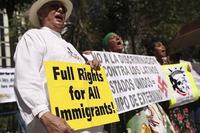-
Biometrics proves 1 percent of applicants to enter U.S. are unsuitable
Chris Archer, the online content editor at IDGA (the Institute for Defense & Government Advancement), talked with James Loudermilk, Senior Level Technologist, FBI Science and Technology Branch, about biometrics and biometrics and homeland security; Loudermilk says that biometrics applications helped the FBI determine that about 1 percent of people who seek visa to visit the United States as tourists have previously done things that make them unsuitable guests; the conversation examines the application of biometrics for homeland security, issues relating to privacy and civil liberties, and what can be learned from international biometrics projects, including India’s UID scheme
-
-
Supreme Court deals near-fatal blow to Arizona SB 1070; states’ immigration efforts now in question

In a major victory for the Obama administration, the U.S. Supreme Court yesterday struck down three of the four main provisions in Arizona’s tough SB 1070 immigration law, saying these provisions were pre-empted by federal law; the Court left in place the fourth provision – the one requiring Arizona local law enforcement during routine stops to check the immigration status of anyone they suspect is in the country illegally – but in reading the provision very narrowly, the Court left its implementation open to legal challenges on grounds that it violates racial profiling prohibition and other laws; in any event, the administration moved quickly to make that remaining provision meaningless by pulling back on a program known as 287(g), which allows the federal government to deputize local officials to make immigration-based arrests; the move means that even if local police step up immigration checks, they will have to rely on federal officials to make the arrests
-
-
Supreme Court suggests Obama’s DREAM initiative is legal
On 15 June the Obama administration announced a new deportation policy, saying that it would defer deportation action against undocumented immigrants in several categories; the administration based its decision on the doctrine of “prosecutorial discretion”; critics charged that such deferment policy is illegal; the Court, in its decision on Arizona SB 1070, suggests the administration is right, saying: “A principal feature of the removal system is the broad discretion exercised by immigration officials”
-
-
Immigration growth in Spain has not caused more crime
Society tends to perceive an increase in the immigrant population with an increase in crime; according to a new study, however, it is not possible to infer this cause-effect relationship in the case of Spain
-
-
Obama and Romney stopped talking about immigration until the Democrats dropped the Dream Bomb

The 15 June announcement by DHS secretary Janet Napolitano of an executive order which, in effect, implements the Dream Act, gives the 2008 presidential election the appearance of offering a discussion of immigration issues; the fact remains, though, that since the Immigration and Reform Act (IRCA) of 1986, both parties studiously avoided a serious debate of the issue during presidential campaigns; democracy is a messy form of government, and few other topics are as messy and convoluted as U.S. immigration policy, but both political parties are wrong to avoid a broad public discussion of this vital national issue
-
-
The changes to the U.S. deportation policy

Last Friday, 15 June 2012, DHS announced what analysts regard as the most significant immigration action in more than two decades; the executive action aims to stop – or defer — the deportation of undocumented youth; individuals cannot yet file for consideration for deferred action under the new policy until the protocols and procedures are announced, which DHS must do within sixty days
-
-
Arizona police preparing to begin implementing SB 1070

Anticipating at least a partially favorable decision from the U.S. Supreme Court on Arizona’s SB 1070 immigration bill, Governor Jan Brewer has issued an executive order instructing police officers across the state to familiarize themselves with the provisions of the law and prepare to begin to implement it; the Court decision is expected before the end of June
-
-
Why the perception persists that undocumented immigrants cause more crime
Undocumented immigrants in the United States do not commit more crimes than native-born Americans, yet the perception persists that they do; researchers found that the belief that undocumented immigrants cause crime was due in part to the perceived population size of the immigrant community overall: if individuals perceive undocumented immigrants to be a larger proportion in the population, they are going to perceive undocumented immigrants as posing a higher level of criminal threat
-
-
CPB’s translation assistance to other agencies questioned
An alliance of immigration advocacy groups says that the U.S. Customs and Border Protection (CBP) has an agenda of its own when it provides translation assistance to other law enforcement agencies and participate in 911 dispatch activities along the U.S.-Canada border: to question individuals about their immigration status and, in many cases, initiate removal proceedings
-
-
Biometric data collection in U.S. immigrant communities and beyond
DHS takes approximately 300,000 fingerprints per day from non-U.S. citizens crossing the border into the United States, and it collects biometrics from noncitizens applying for immigration benefits and from immigrants who have been detained; in addition, state and local law enforcement officers regularly collect fingerprints and DNA, as well as face prints and even iris scans
-
-
Young undocumented immigrants in U.S. face obstacles, difficult futures
Undocumented Latino youth who migrate to the United States face futures clouded by limited rights and the constant fear of deportation, a new study finds; “Rites of passage common to American youth — getting a driver’s license, traveling, working and applying to college — are either denied, unattainable or dangerous to pursue for undocumented immigrants,” said one of the authors of the study
-
-
New approach to U.S. border security

CBP has unveiled a new approach to securing the U.S.-Mexico border; the new strategy puts less emphasis on technology, and more on risk analysis; the Border Patrol believes it now knows enough about those who try to cross the border to begin imposing more serious consequences on almost everyone the agency catches; in January the Border Patrol expanded its Consequence Delivery System to the entire border, dividing border crossers into seven categories, ranging from first-time offenders to people with criminal records
-
-
Critics slam administration’s “minor offenses” deportation stance
Critics if the administration’s immigration policies slam the administration’s last week announcement that it will no longer initiate enforcement actions against deportable aliens identified by the Secure Communities program who have committed minor criminal offenses
-
-
Supreme Court hears arguments on Arizona immigration law
The U.S. Supreme Court yesterday heard arguments about the tough Arizona immigration law, known as SB107; the case highlights a fundamental disagreements over the precise balance of power between the states and the national government; the judges appeared skeptical of the administration’s arguments; the Arizona case may occasion a redrawing by the Supreme Court of established boundaries between the federal government and the states on immigration enforcement
-
-
Increasing effectiveness of border patrols by making them random
A new study finds that combining historical data on illegal border crossings with unpredictability and randomness of patrols would be the most effective approach to increase interdiction of illegal border crossers
-
- All
- Regional
- Water
- Biometrics
- Borders/Immig
- Business
- Cybersecurity
- Detection
- Disasters
- Government
- Infrastructure
- International
- Public health
- Public Safety
- Communication interoperabillity
- Emergency services
- Emergency medical services
- Fire
- First response
- IEDs
- Law Enforcement
- Law Enforcement Technology
- Military technology
- Nonlethal weapons
- Nuclear weapons
- Personal protection equipment
- Police
- Notification /alert systems
- Situational awareness
- Weapons systems
- Sci-Tech
- Sector Reports
- Surveillance
- Transportation
Advertising & Marketing: advertise@newswirepubs.com
Editorial: editor@newswirepubs.com
General: info@newswirepubs.com
2010-2011 © News Wire Publications, LLC News Wire Publications, LLC
220 Old Country Road | Suite 200 | Mineola | New York | 11501
Permissions and Policies
Editorial: editor@newswirepubs.com
General: info@newswirepubs.com
2010-2011 © News Wire Publications, LLC News Wire Publications, LLC
220 Old Country Road | Suite 200 | Mineola | New York | 11501
Permissions and Policies
